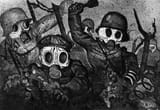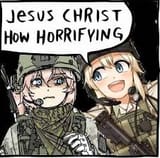>>64020988usually what happens is that the losing side - whether police or mob - do what the armchair historians call
>lose cohesion>become disorganised>suffer a collapse in command authority>breaks and runsbringing up incidences of riot police failure is interesting, because unlike mobs, which fight the same way ancient "barbarian" tribes did, riot police have better training, at least as much as Roman legionaries did. so from this we can get an idea of how barbarians might have broken the occasional Roman legion.
riot police are trained to always stay in a formation and work as a platoon of 10 to 20. their tactics are to pick off the "barbarian champions" and then form a shield wall to withstand assault. because they essentially have the same equipment as a Roman or hoplite legion - shield and truncheon in place of sword - they fight like a Roman or hoplite legion, minus spears and javelins.
(when they have riot guns then they do get those)
so how do riot police get defeated?
when they're outnumbered and battered down in what the armchair historians call "pushing contests", just like hoplite phalanxes
or flanked unexpectedly, again like Greek phalanxes
or break formation due to broken terrain, like Greek phalanxes (often happens in urban riots)
or due to physical weakness, as at Lake Trasimene
or being surrounded, as at Cannae
>The reason for this is that an angry crowd can suddenly feel a sense of great powerno; that sense is more the result of seeing a great number of tactical weaknesses such as noticing that the riot police are outnumbered, cut off, etc
>and the police get the order from higher up to bug outusually the rout then is due to the police panicking
which is not surprising. fighting withdrawals are probably the most difficult of all operations.





